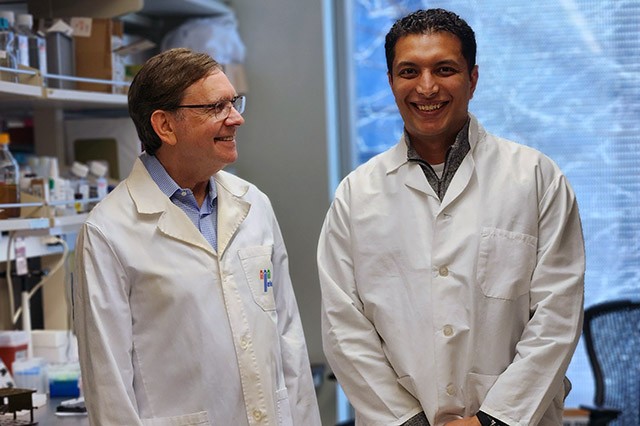New gene therapy breakthrough offers hope for Duchenne muscular dystrophy patients
A groundbreaking gene therapy for Duchenne muscular dystrophy (DMD) has demonstrated significant potential in not only arresting muscle decline but also possibly repairing damaged muscle tissue. This novel treatment, developed by researchers at UW Medicine, utilises a series of protein packets delivered via viral vectors to replace the defective DMD gene within affected muscles.

Muscular dystrophy gene therapy researchers Jeffrey Chamberlain (left) and Hichem Tasfaout in their lab. — Courtesy of Chamberlain Lab
The science behind the breakthrough
The research, published in Nature [1], focuses on delivering genetic material to produce dystrophin, the protein absent in DMD patients. Dr Jeffery Chamberlain, senior author of the study and director of the Wellstone Muscular Dystrophy Research Center at the University of Washington School of Medicine, has dedicated his career to finding therapeutics for muscular dystrophy.
One of the primary challenges in developing an effective treatment for DMD has been the sheer size of the gene requiring correction. Dr Chamberlain explains, “Think of having a king-sized bed delivered that you can’t get through your door.” This analogy aptly describes the difficulty researchers have faced in delivering the necessary genetic material into muscle cells.
A novel delivery method
The new approach utilises a series of adeno-associated viral vectors (AAVs), which act as tiny shuttles derived from viruses. These AAVs transport parts of the therapeutic protein into the muscles, along with embedded instructions for assembling the genetic fix once inside the body.
Dr Hichem Tasfaout, the lead researcher on the project, likens this process to delivering and assembling a bed piece by piece once inside the house. This innovative method has shown success in mouse models, not only halting disease progression but also reversing much of the pathology associated with dystrophy.
Reducing side effects
The latest approach employs a new type of AAV vector that allows for lower doses, potentially reducing or eliminating many of the side effects associated with previous gene therapy attempts. Dr Chamberlain notes, “When we infuse a large dose of these delivery shuttles, the body goes ‘Whoa, what’s going on here?’” This reaction can trigger an immune response that may damage the heart or liver.
By using smaller doses, the researchers hope to mitigate these risks and improve the overall safety profile of the treatment.
Future prospects
The next step for this promising therapy is human trials, which are expected to begin in approximately two years. Dr Chamberlain and Dr Tasfaout are optimistic that this method could eventually lead to a reversal of muscle wasting and restore normal health to muscle tissue.
DMD is an inherited genetic disease that primarily affects males, as the defective gene is located on the X chromosome. Patients typically begin exhibiting symptoms around four years of age and often succumb to the disease in their 20s or 30s. Currently, there is no cure for DMD, and available treatments only slow disease progression.
This new gene therapy offers hope for a more effective treatment that could potentially transform the lives of DMD patients and their families.
A personal mission
Dr Chamberlain’s passion for finding a cure for muscular dystrophy was sparked in his youth when he watched the Jerry Lewis Telethon. He went on to become an expert who discussed the science of therapies on the telethon multiple times.
“When you meet families and patients, it just inspires me to work that much harder,” Dr Chamberlain reflects, highlighting the personal impact of his research on those affected by DMD.
Funding and support
The research was primarily supported by the Muscular Dystrophy Association, with additional funding raised through a series of fundraisers hosted by former Seattle Mariner Edgar Martinez. This collaborative effort between researchers, charitable organisations, and public figures underscores the importance of continued support for medical research.
As this promising gene therapy moves towards human trials, it offers renewed hope for DMD patients and their families. The potential to not only halt disease progression but also repair damaged muscle tissue represents a significant leap forward in the treatment of this devastating condition.
Reference
- Tasfaout, H., Halbert, C. L., McMillen, T. S., et. al (2024). Split intein-mediated protein trans-splicing to express large dystrophins. Nature.
https://doi.org/10.1038/s41586-024-07710-8

